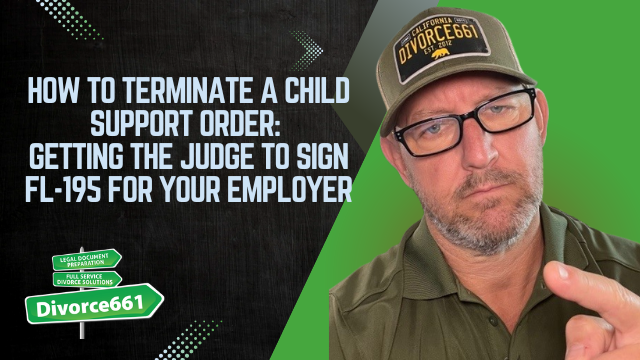How to Terminate a Child Support Order: Getting the Judge to Sign FL-195 for Your Employer
If you’re currently paying child support and approaching the time when the order needs to end, it’s important to understand the proper steps to officially terminate the support. This guide, inspired by the expertise of Tim Blankenship from Divorce661, explains how to get the judge to sign the necessary FL-195 form so your employer can stop withholding child support from your paycheck.
Understanding the FL-195 Income Withholding Order
The FL-195 is a court-issued income withholding order that is typically served on your employer. It instructs them on how much child support or spousal support to deduct from your wages. This order stays in effect until the court officially terminates it.
If you or your employer are still operating under an FL-195, it means that support payments will continue to be deducted from your paycheck. But what happens when the time comes to stop these deductions, such as when your child turns 18 and child support should end?
Why You Need a Court Order to Terminate Child Support
Simply informing your employer that child support should stop is not enough. If your employer has a previously signed FL-195, they will require a new court order confirming the termination of child support before they can stop withholding payments.
This means you must return to court and file a motion to have the judge sign an official order terminating the child support. Without this signed order, your employer is legally obligated to continue withholding support.
Key Point:
- If child support was originally ordered and your employer has a signed FL-195, a new court order is required to end the withholding.
- This new order must be signed by the judge and then served on your employer.
Planning Ahead: Timing is Crucial
One common challenge is timing. The process of filing a motion and obtaining a judge’s signature on the termination order can take approximately 60 days or more. This means you need to plan well in advance—at least four to five months before child support should end.
For example, if your child is turning 18 and support should stop at that time, waiting until the last minute to file for termination can result in your employer continuing to withhold child support beyond the necessary period. This happens because the employer needs the official court order to make any changes to the deductions.
In many cases, support payments may continue for a short time after the child support obligation has ended, simply because the paperwork hasn’t caught up yet. To avoid this, start the process early so you can minimize unnecessary deductions and potential confusion.
Steps to Terminate Child Support Successfully
- File a Motion with the Court: Initiate the process by filing a motion requesting termination of the child support order.
- Obtain a Judge’s Signature on the New Order: The court will review your motion, and if everything is in order, the judge will sign the FL-195 termination order.
- Serve the New Order to Your Employer: Once signed, this order must be served to your employer so they can stop withholding child support from your paycheck.
Final Thoughts
Terminating a child support order is not an automatic process and requires legal steps to ensure all parties—especially your employer—are properly informed. The key takeaway is to be proactive and plan ahead to avoid unnecessary withholding after your child support obligation ends.
If you are facing this situation, consider reaching out to a legal professional who can assist you with filing the correct paperwork and navigating the court process efficiently.
For more guidance or assistance with child support termination and related family law matters, you can contact Divorce661 at 661-2867 or visit their website at www.divorce661.com.

